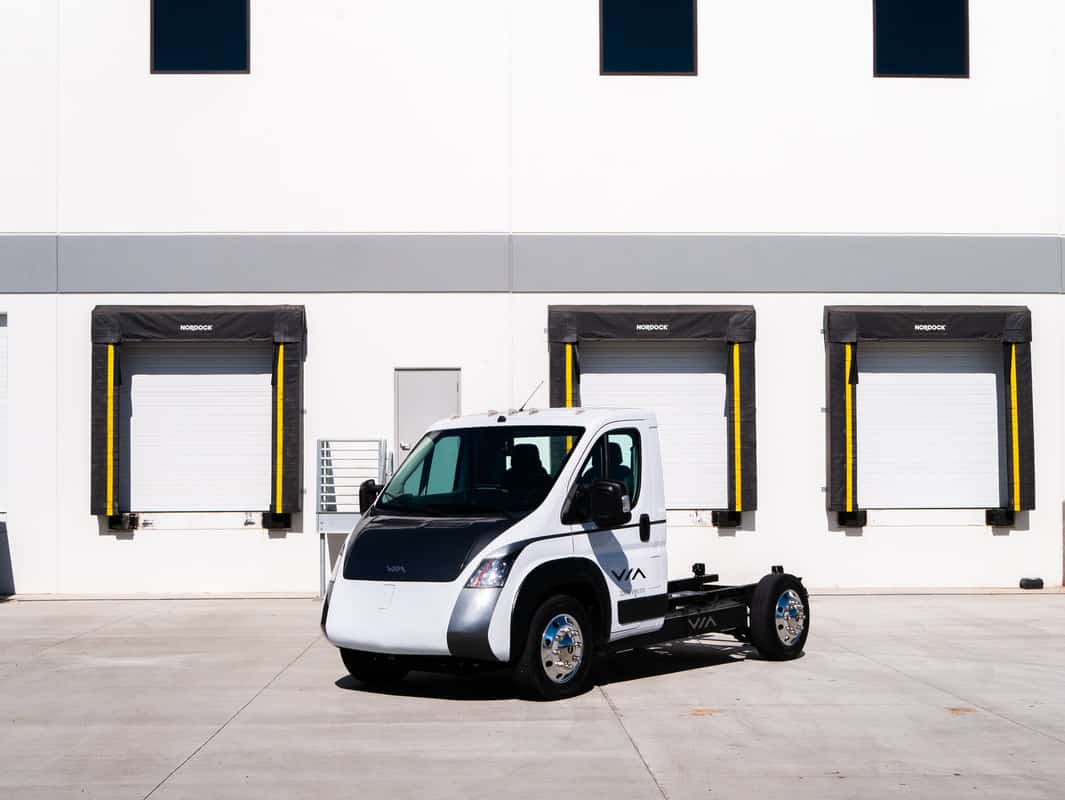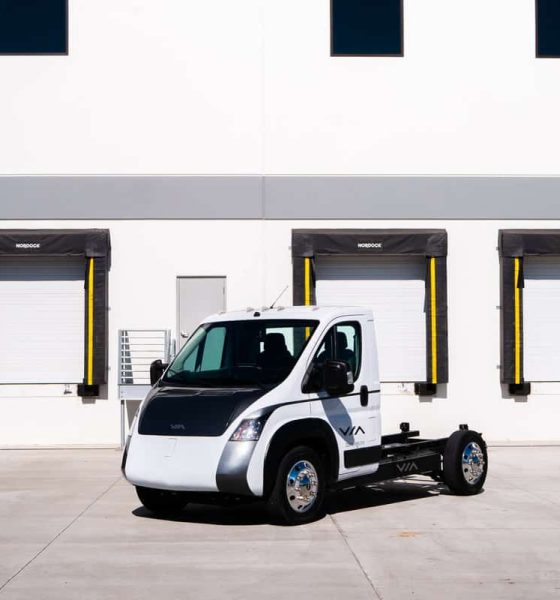VIA Motors, a commercial electric truck manufacturer, has been acquired by global EV company Ideanomics.
Ideanomics has been on a tear over the past two years, acquiring electric vehicle startups producing motorcycles, tractors, and electric delivery vans, all part of its mission to electrify mobility globally. Now, Ideanomics has acquired VIA Motors, an American commercial electric truck manufacturer that will be working to introduce its first vehicle and potentially license its hardware in the near future.
Ideanomics has brought some relatively interesting ideas to the table in terms of EV development. It even has ideas for completely wireless charging for EVs, a strategy that could be adopted for the all-electric Tesla Semi, among others.
“Our acquisition of VIA Motors brings significant revenue generation potential to Ideanomics and its shareholders,” says Ideanomics Executive Chairman Shane McMahon. ”We cannot be more thrilled to welcome VIA to Ideanomics.” The new acquisition joins five other businesses as part of Ideanomics’ electric mobility push, including its EV charger subsidiary, which “will become the preferred charging solutions provider for VIA.”
$IDEX + @VIAMotorsInc = fast, easy and affordable fleet electrification.
Combining VIA’s #electric work trucks w/ our wireless and containerized charging tech is a game-changer! pic.twitter.com/VQuWhexOGc
— Ideanomics (@ideanomicshq) January 27, 2023
According to the VIA Motors website, the company currently sells one vehicle, its cab-chassis electric truck, which can be outfitted with any standard bed or box, much like any other commercial van. The electric truck comes in three distinct lengths and is well-fitted for delivery use, in which case a box is fitted to the back.
VIA’s truck retains the power necessary for a commercial truck with a payload of 6,900 pounds, but its AWD electric drivetrain allows owners and operators to save on fuel and repair. The system uses an 82kWh battery, capable of a range of 114 miles, and can be charged in roughly 45 minutes from 0 to 100 percent using DC fast charging.
While these specifications may not be anything to brag about yet, VIA now has a couple of tricks up its sleeves after its acquisition today. Through Ideanomics’ other partnership with Energica Motors, VIA now has access to in-house designed motors, which have already made their way into Ideanomics’ tractor business, Solectrac. Furthermore, with fresh investment from the fund, VIA may be able to do something other van startups have trouble doing; producing.
This isn’t to say VIA faces no challenge in the electric van market, far from it. Ford currently controls most of the electric van segment with its E-Transit offering. At the same time, Rivian, through investment from Amazon, continues to ramp up production of its own electric van. Even Canoo, a company on the brink of bankruptcy only a year ago, is now entering production with thousands of new orders from Walmart and the U.S. Army.
Walmart commits to purchase 4,500 Canoo all-electric delivery vans
As Ideanomics continues to grow, it is continuing to become a far more formidable force in electric mobility, leaving many to wonder which other industries the company may look to invest in next. However, with each of its investments, it faces a significant challenge from the legacy brands within each industry. The coming year will certainly be a test as each of its brands looks to grow in the electrifying market.
What do you think of the article? Do you have any comments, questions, or concerns? Shoot me an email at william@teslarati.com. You can also reach me on Twitter @WilliamWritin. If you have news tips, email us at tips@teslarati.com!

News
Tesla FSD fleet is nearing 7 billion total miles, including 2.5 billion city miles
As can be seen on Tesla’s official FSD webpage, vehicles equipped with the system have now navigated over 6.99 billion miles.

Tesla’s Full Self-Driving (Supervised) fleet is closing in on almost 7 billion total miles driven, as per data posted by the company on its official FSD webpage.
These figures hint at the massive scale of data fueling Tesla’s rapid FSD improvements, which have been quite notable as of late.
FSD mileage milestones
As can be seen on Tesla’s official FSD webpage, vehicles equipped with the system have now navigated over 6.99 billion miles. Tesla owner and avid FSD tester Whole Mars Catalog also shared a screenshot indicating that from the nearly 7 billion miles traveled by the FSD fleet, more than 2.5 billion miles were driven inside cities.
City miles are particularly valuable for complex urban scenarios like unprotected turns, pedestrian interactions, and traffic lights. This is also the difference-maker for FSD, as only complex solutions, such as Waymo’s self-driving taxis, operate similarly on inner-city streets. And even then, incidents such as the San Francisco blackouts have proven challenging for sensor-rich vehicles like Waymos.
Tesla’s data edge
Tesla has a number of advantages in the autonomous vehicle sector, one of which is the size of its fleet and the number of vehicles training FSD on real-world roads. Tesla’s nearly 7 billion FSD miles then allow the company to roll out updates that make its vehicles behave like they are being driven by experienced drivers, even if they are operating on their own.
So notable are Tesla’s improvements to FSD that NVIDIA Director of Robotics Jim Fan, after experiencing FSD v14, noted that the system is the first AI that passes what he described as a “Physical Turing Test.”
“Despite knowing exactly how robot learning works, I still find it magical watching the steering wheel turn by itself. First it feels surreal, next it becomes routine. Then, like the smartphone, taking it away actively hurts. This is how humanity gets rewired and glued to god-like technologies,” Fan wrote in a post on X.
News
Tesla starts showing how FSD will change lives in Europe
Local officials tested the system on narrow country roads and were impressed by FSD’s smooth, human-like driving, with some calling the service a game-changer for everyday life in areas that are far from urban centers.

Tesla has launched Europe’s first public shuttle service using Full Self-Driving (Supervised) in the rural Eifelkreis Bitburg-Prüm region of Germany, demonstrating how the technology can restore independence and mobility for people who struggle with limited transport options.
Local officials tested the system on narrow country roads and were impressed by FSD’s smooth, human-like driving, with some calling the service a game-changer for everyday life in areas that are far from urban centers.
Officials see real impact on rural residents
Arzfeld Mayor Johannes Kuhl and District Administrator Andreas Kruppert personally tested the Tesla shuttle service. This allowed them to see just how well FSD navigated winding lanes and rural roads confidently. Kruppert said, “Autonomous driving sounds like science fiction to many, but we simply see here that it works totally well in rural regions too.” Kuhl, for his part, also noted that FSD “feels like a very experienced driver.”
The pilot complements the area’s “Citizen Bus” program, which provides on-demand rides for elderly residents who can no longer drive themselves. Tesla Europe shared a video of a demonstration of the service, highlighting how FSD gives people their freedom back, even in places where public transport is not as prevalent.
What the Ministry for Economic Affairs and Transport says
Rhineland-Palatinate’s Minister Daniela Schmitt supported the project, praising the collaboration that made this “first of its kind in Europe” possible. As per the ministry, the rural rollout for the service shows FSD’s potential beyond major cities, and it delivers tangible benefits like grocery runs, doctor visits, and social connections for isolated residents.
“Reliable and flexible mobility is especially vital in rural areas. With the launch of a shuttle service using self-driving vehicles (FSD supervised) by Tesla in the Eifelkreis Bitburg-Prüm, an innovative pilot project is now getting underway that complements local community bus services. It is the first project of its kind in Europe.
“The result is a real gain for rural mobility: greater accessibility, more flexibility and tangible benefits for everyday life. A strong signal for innovation, cooperation and future-oriented mobility beyond urban centers,” the ministry wrote in a LinkedIn post.
News
Tesla China quietly posts Robotaxi-related job listing
Tesla China is currently seeking a Low Voltage Electrical Engineer to work on circuit board design for the company’s autonomous vehicles.

Tesla has posted a new job listing in Shanghai explicitly tied to its Robotaxi program, fueling speculation that the company is preparing to launch its dedicated autonomous ride-hailing service in China.
As noted in the listing, Tesla China is currently seeking a Low Voltage Electrical Engineer to work on circuit board design for the company’s autonomous vehicles.
Robotaxi-specific role
The listing, which was shared on social media platform X by industry watcher @tslaming, suggested that Tesla China is looking to fill the role urgently. The job listing itself specifically mentions that the person hired for the role will be working on the Low Voltage Hardware team, which would design the circuit boards that would serve as the nervous system of the Robotaxi.
Key tasks for the role, as indicated in the job listing, include collaboration with PCB layout, firmware, mechanical, program management, and validation teams, among other responsibilities. The role is based in Shanghai.
China Robotaxi launch
China represents a massive potential market for robotaxis, with its dense urban centers and supportive policies in select cities. Tesla has limited permission to roll out FSD in the country, though despite this, its vehicles have been hailed as among the best in the market when it comes to autonomous features. So far, at least, it appears that China supports Tesla’s FSD and Robotaxi rollout.
This was hinted at in November, when Tesla brought the Cybercab to the 8th China International Import Expo (CIIE) in Shanghai, marking the first time that the autonomous two-seater was brought to the Asia-Pacific region. The vehicle, despite not having a release date in China, received a significant amount of interest among the event’s attendees.










